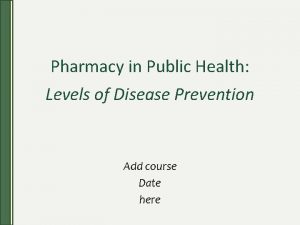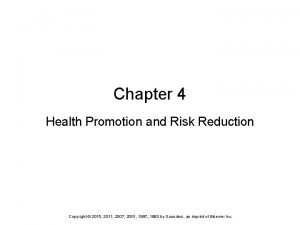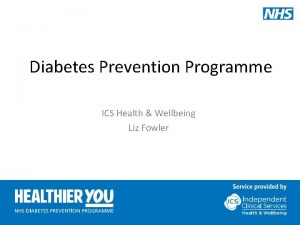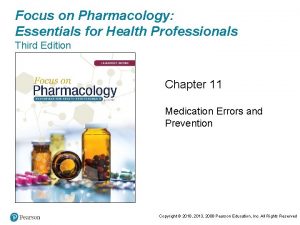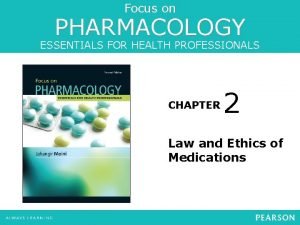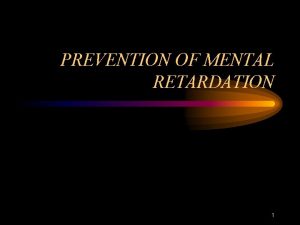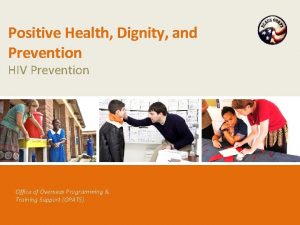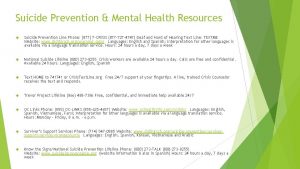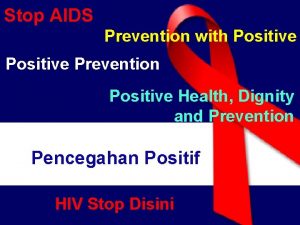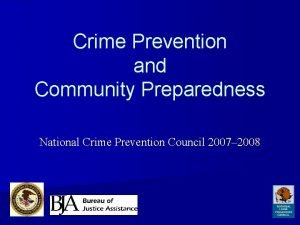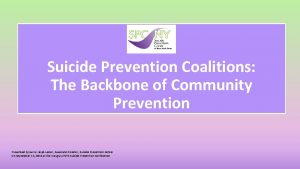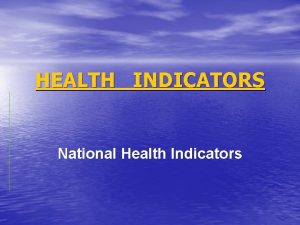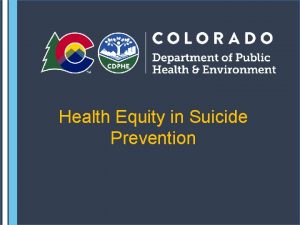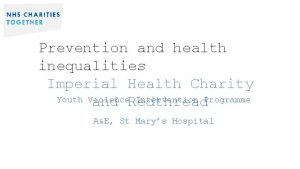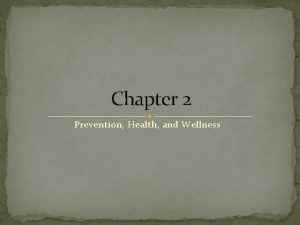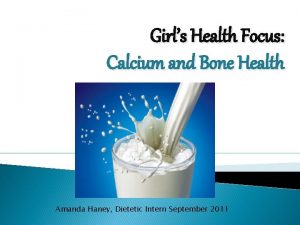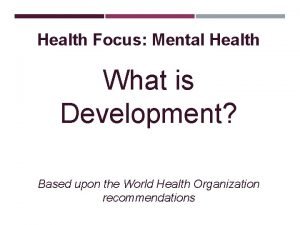Community Prevention Focus on the Community Community Health






































- Slides: 38

Community Prevention Focus on the Community

Community Health Prevention • Its more effective to target groups rather than individuals • Interdependent on educational, social and environmental actions a population

Educational • Strategies for addressing high risk youth (ACES study), families, special populations, policy makers.

Social • Changes in economic, political, legal, and organizational dimension

Environmental • Address physical and biological factors (housing conditions)

Geoffrey Rose’s Strategy of Preventative Medicine • Geoffrey Rose (19 April 1926 – 12 November 1993) epidemiologist whose ideas have been credited with transforming the approach to strategies for improving health.

• Risk factors for a large number of diseases and health problems are distributed in populations in a graded manner. • There is often no obvious and clinically meaningful risk factor threshold that differentiates those at risk and those not at risk for chronic disease. • For many chronic diseases, there are many more people in a population at a relatively moderate level of risk than at the highest level of risk. • Addressing only the very high risk population misses an opportunity to improve risk profile of the entire population

• Moderate risk lowering among many persons with moderate risk will favorably shift the risk profile of the entire population. • A population wide approach is the best, the objective should to reduce average risk level of a population by intervening with all and intense intervention for those at highest level of risk.

High-risk strategy • focuses its efforts on needy individuals with the highest levels of the risk factor, and utilizes the established framework of medical services. • a targeted rescue operation for vulnerable individuals.

Pros • the intervention may be matched to the needs of the individual • it may avoid interference with those who are not at a special risk • it may be accommodated within the ethical and cultural values, organization, and economics, of the health care system • selectivity may increase the likelihood of a cost-effective use of resources

Cons • prevention may become medicalized • success may be palliative and temporary; the contribution to overall (population) control of a disease may be small • the preventive intervention may be behaviorally or culturally inadequate or unsustainable • it has a poor ability to predict which individuals will benefit from the intervention

Population Strategy • public health-oriented approach to preventive medicine and public health which predicts that shifting the population distribution of a risk factor prevents more BURDEN OF DISEASE than targeting people at high risk. • accommodates for members of the community who were at low risk • recognizes that the occurrence of common exposures and diseases reflects the functioning of society as a whole

Pros • the societal effects of a distributional shift may be large • it may be more culturally appropriate and sustainable to seek a general change in behavioral norms and in the social values that facilitate their adoption than to attempt to individually change behaviors that are socially conditioned

Cons • it offers only a small benefit to each participating individual, which may be wiped out by a small risk • it requires major changes in the economics and mode of functioning of society, which often makes changes unlikely. Individuals generally prefer to pay as late as possible, and to enjoy the benefits as soon as possible

SAMHSA Strategic Prevention Framework

Assessment • Define community problem • Determine underlining risk and protective factors • Mobilize stakeholders • Build state and local infrastructures for data collection

Capacity • Identify resources • Gather stakeholders 1. Build capacity 2. Determine policies +practice 3. Identified culturally competent factors 4. Determine sustainability

Planning • Address problems identified • Identify performance targets and action plans • Select evidence based polices and programs

Implementation • Put programs into effect • Monitor implementation • Ensure sustainability

Evaluation • Conduct a formative and summative assessment of the program • Evaluate efficacy • Evaluate efficiency • Evaluate fidelity to the EBP • Correct areas that are not working • Ensure sustainability

Institute of Medicine Classification of Prevention Efforts (IOM) • Universal prevention strategies: Designed to address large population (whole school district vs just seniors at one school) • Selective prevention strategies: target specific groups or subgroups (children on reduced/ free lunch) • Indicated prevention strategies: subpopulations already engaged in substance use or are displaying high risk factors.

Public Health PRECEDE-PROCEED Model • Two health promotion planning components: diagnosis and development.

PRECEDE • P-predisposing • R-reinforcing • E-enabling • C-constructs in • E-education and environmental • D-diagnosis • E-evaluation

PROCEED • P-policy • R-regulatory • O-organizational • C-constructs in • E-educational and • E-environmental • D-development

PRECEDE/ PROCEED Phase 1 • Social diagnosis-determines factors that affect a community’s quality of life.

PRECED/ PROCEED Phase 2 • Epidemiological diagnosis-provides objective assessment of a community’s health status.

PRECEDE/ PROCEED phase 3 • Behavioral and Environmental Diagnosis-identify the targets for intervention. • Behavioral Diagnosis 1. Determine behaviors related to health problem 2. Rate relative importance and changeability of behaviors 3. Select behavior targets 4. State behavioral objectives

• Environmental Diagnosis 1. Determine environmental factors related to health problem 1. Rate relative importance and changeability of environmental factors 2. Select environmental factors targets 3. State environmental factors objectives

PRECEDE/ PROCEED Phase 4 • Educational and organizational diagnosis • Identify the motivational, organizational, and social conditions associated with the health behavior. • Which factors predispose (motivate) an individual to behave in a particular way? • Which factors enable (assist) an individual to act this way? • Which factors reinforce (reward) the behavior?

PRECEDE/ PROCEED Phase 5 • Administrative and policy diagnosis • Determine availability of resources

PRECEDE/ PROCEED Phase 6 • Initiates the implementation of the model

PRECEDE/ PROCEED Phases 7, 8, &9 • Evaluation

PATCH Model • the Planned Approach To Community Health • Developed by the CDC in 1980’s • Bottom-up approach • Focuses on community empowerment • Focuses on core of local support • Gathers data • Establishes objectives and standards

Ecological Model • AKA biopsychosocial model • Reciprocal interaction of environmental and individual factors (supported employment, housing, childcare) • Five levels of influence 1. Individual 2. Interpersonal 3. Organizational 4. Community 5. Societal

Social Cognitive Model • Evolution of social learning theory- individuals learn by observing others/ observation (modeling) • Reciprocal determinism: a persons behavior influences the environment and the environment influences the person’s behavior • Four components influencing modeling behavior 1. Attention (is it interesting) 2. Retention (is it memorable) 3. Reproduction (can you recreate it) 4. Motivation (what reinforcement was there)

Social Development Model • Social interactions precede development, cognition is an end product on socialization and social behavior. • Resiliency is increased by increasing protective factors (pro-social bonding) and decreasing risk factors. • Zone of proximal development (ZPD-where does the learning occur) • More knowledgeable other (MKO-who has the high ability level in social interactions)

Social Context Model • Reciprocal Determinism-behavior is shaped by reciprocal interaction of cognitive, behavioral, and environmental factors. • Teen drinking occurs-away from school, on weekends, unsupervised

Evidence Based Approaches: • SAMSHA’s definition 1. Inclusion on federal registry of evidence based intervention 2. Reported in peer reviewed journals 3. Documented effectiveness supported by other sources of information, follows 4 guidelines: 1. Intervention is based on a theory of change that is documented in a clear logic or conceptual model. 2. intervention is similar in content and structure to interventions that appear in registries and/ or peer reviewed journals. 3. Intervention is supported by documentation that is been effectively implemented in the past, and multiple times, in a manner attentive to scientific standards. 4. Intervention is reviewed and deemed appropriate by a panel of informed prevention experts
 Primary prevention secondary prevention tertiary prevention
Primary prevention secondary prevention tertiary prevention Focus on form vs focus on forms
Focus on form vs focus on forms Porters strategies
Porters strategies Differentiation business level strategy
Differentiation business level strategy Actor focus vs object focus
Actor focus vs object focus Health promotion and levels of disease prevention
Health promotion and levels of disease prevention Health promotion and levels of disease prevention
Health promotion and levels of disease prevention Ics health and wellbeing
Ics health and wellbeing Roles of occupational health nurse
Roles of occupational health nurse Focus on pharmacology essentials for health professionals
Focus on pharmacology essentials for health professionals Lomotib
Lomotib Hát kết hợp bộ gõ cơ thể
Hát kết hợp bộ gõ cơ thể Bổ thể
Bổ thể Tỉ lệ cơ thể trẻ em
Tỉ lệ cơ thể trẻ em Chó sói
Chó sói Thang điểm glasgow
Thang điểm glasgow Chúa yêu trần thế alleluia
Chúa yêu trần thế alleluia Các môn thể thao bắt đầu bằng từ đua
Các môn thể thao bắt đầu bằng từ đua Thế nào là hệ số cao nhất
Thế nào là hệ số cao nhất Các châu lục và đại dương trên thế giới
Các châu lục và đại dương trên thế giới Công thức tiính động năng
Công thức tiính động năng Trời xanh đây là của chúng ta thể thơ
Trời xanh đây là của chúng ta thể thơ Mật thư tọa độ 5x5
Mật thư tọa độ 5x5 Làm thế nào để 102-1=99
Làm thế nào để 102-1=99 độ dài liên kết
độ dài liên kết Các châu lục và đại dương trên thế giới
Các châu lục và đại dương trên thế giới Thể thơ truyền thống
Thể thơ truyền thống Quá trình desamine hóa có thể tạo ra
Quá trình desamine hóa có thể tạo ra Một số thể thơ truyền thống
Một số thể thơ truyền thống Cái miệng nó xinh thế chỉ nói điều hay thôi
Cái miệng nó xinh thế chỉ nói điều hay thôi Vẽ hình chiếu vuông góc của vật thể sau
Vẽ hình chiếu vuông góc của vật thể sau Nguyên nhân của sự mỏi cơ sinh 8
Nguyên nhân của sự mỏi cơ sinh 8 đặc điểm cơ thể của người tối cổ
đặc điểm cơ thể của người tối cổ V cc cc
V cc cc Vẽ hình chiếu đứng bằng cạnh của vật thể
Vẽ hình chiếu đứng bằng cạnh của vật thể Tia chieu sa te
Tia chieu sa te Thẻ vin
Thẻ vin đại từ thay thế
đại từ thay thế





